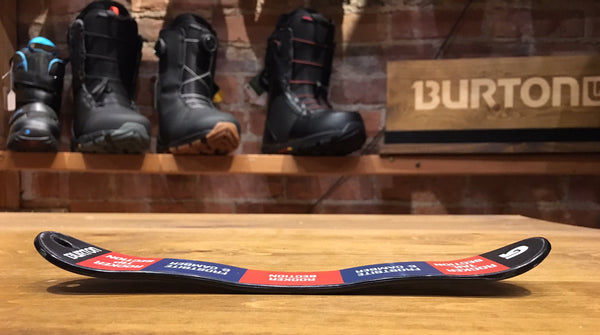Let's Talk About Camber
We get a lot of questions about camber in the shop. So for those of you who want to learn more about what camber is and how it effects the way that you ride, read on good people!
Camber is essentially the natural shape (or flex) of the board at rest. Imagine looking at your snowboard perfectly from the side and seeing the way the edge of the board curves slightly from tip to tail. It’s from that view that you can tell the camber of a board.
Regular Camber:

What:
Regular Camber, features a slight rise in the center of the board. If you can stretch your memory back to your grade 9 science class, you may recall the term “convex”, which would apply here.
The slight rise in the center of the board will slope down as it nears the tip and tail and give the board four edge contact points at the bottom of that slope.
Why:
Giving the board this convex shape effectively does two things:
1) Grip: as mentioned above, the convex shape to the board gives it four contact points at the board’s edge near the tip and tail. The result is that the board can grip better and so the rider will experience more power, edge hold and control.
2) Pop: the convex shape gives the board a whole lot of pop and ollie power. Think snappy and responsive.
Where:
A snappy board with ample control is a great board for the hill. It will have you slaying groomers and carving smoothly, while also rocking the park with lots of give and play. Depending on the materials and design of the board, it can also make for a great all-mountain board that will have you slashing pow with play & precision through the trees.
Who:
Catching edges is one of the hardest obstacles to overcome for new riders, which typically means that regular camber is a better choice for intermediate to experienced riders who crave that kind of control.
Keep in mind that each company designs their boards with different features, so this isn’t an exact science. It’s more of a great starting point when venturing into the world of snowboard geekery. It’s always a good idea to ask your friendly neighborhood snowboard shop about each board specifically.
Reverse Camber:

What:
Reverse Camber (otherwise known as ‘rocker’) is the opposite of Regular Camber. Bet you didn’t see THAT coming. If you can push your memory back just a little bit further into your high school reservoir you might remember the term “concave”, which would apply to this shape. When looking down the edge of the board you’ll see a consistent scoop shape – like a boat.
Why:
When the board has a boat like shape to it, the four contact points move towards the center of the board, while the tip and tail get lifted up off the snow slightly. This effectively makes the board’s edges less catchy and the whole board will pivot and jive more easily.
Where:
Reverse Camber makes for an awesome all-mountain board and is a good option for beginner riders who want to explore the mountain.
Who:
Reverse Camber can be an awesome choice for beginners, intermediates, new park riders, jibbers and those looking for easy float in pow. It’s a great option for newbies since it’s harder to catch an edge, reverse camber can make learning to ride a lot easier (and less painful).
The nice thing about snowboard technology is that companies can get pretty creative with materials in order to generate multiple benefits. Plenty of the higher end boards will blend a reverse camber with a snappier wood (like bamboo) or carbon strings in order to improve the edge control and increase the pop of the board; which can make a reverse camber board awesome for all-mountain terrain. Again, it varies on a board-to-board basis.
Hybrid Camber:

What:
You guessed it: Hybrid Camber is a combination of regular and reverse camber, resulting in what might look like a bit of a wave from the side view.
Why:
Hybrid Camber can reap the best of both worlds, and the design results in a highly customized board feel. Some boards, like the Burton Flying V or many of the Lib Tech boards, will have camber under foot and reverse camber between the bindings; whereas other hybrids (like many of the Jones, slash and YES boards) will have camber between the bindings with an early rise rocker on either side of the bindings.
Who & Where:
Hybrid Camber boards have a very unique feel, and are (in theory) the best of both worlds. They often feature a combination of pop and edge control with high performance versatility. Intermediate and experienced riders will typically cotton to a hybrid board more quickly than a beginner.
And that’s it folks. If you’re keen to know more, drop on by the shop and we’ll learn you up real good!
